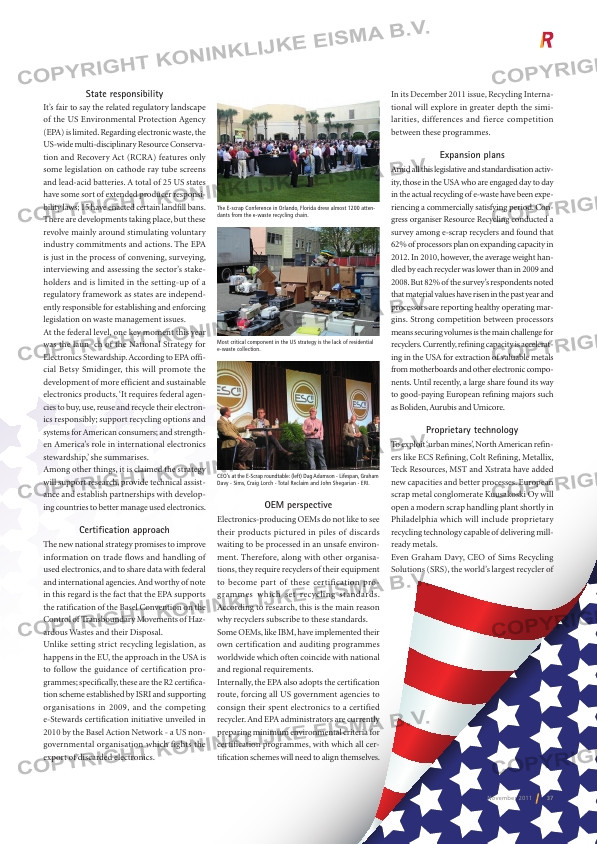Page 37 from: November 2011

37November 2011
State responsibility
It’s fair to say the related regulatory landscape
of the US Environmental Protection Agency
(EPA) is limited. Regarding electronic waste, the
US-wide multi-disciplinary Resource Conserva-
tion and Recovery Act (RCRA) features only
some legislation on cathode ray tube screens
and lead-acid batteries. A total of 25 US states
have some sort of extended producer responsi-
bility laws; 15 have enacted certain landfill bans.
There are developments taking place, but these
revolve mainly around stimulating voluntary
industry commitments and actions. The EPA
is just in the process of convening, surveying,
interviewing and assessing the sector’s stake-
holders and is limited in the setting-up of a
regulatory framework as states are independ-
ently responsible for establishing and enforcing
legislation on waste management issues.
At the federal level, one key moment this year
was the laun ch of the National Strategy for
Electronics Stewardship. According to EPA offi-
cial Betsy Smidinger, this will promote the
development of more efficient and sustainable
electronics products. ‘It requires federal agen-
cies to buy, use, reuse and recycle their electron-
ics responsibly; support recycling options and
systems for American consumers; and strength-
en America’s role in international electronics
stewardship,’ she summarises.
Among other things, it is claimed the strategy
will support research, provide technical assist-
ance and establish partnerships with develop-
ing countries to better manage used electronics.
Certification approach
The new national strategy promises to improve
information on trade flows and handling of
used electronics, and to share data with federal
and international agencies. And worthy of note
in this regard is the fact that the EPA supports
the ratification of the Basel Convention on the
Control of Transboundary Movements of Haz-
ardous Wastes and their Disposal.
Unlike setting strict recycling legislation, as
happens in the EU, the approach in the USA is
to follow the guidance of certification pro-
grammes; specifically, these are the R2 certifica-
tion scheme established by ISRI and supporting
organisations in 2009, and the competing
e-Stewards certification initiative unveiled in
2010 by the Basel Action Network – a US non-
governmental organisation which fights the
export of discarded electronics.
OEM perspective
Electronics-producing OEMs do not like to see
their products pictured in piles of discards
waiting to be processed in an unsafe environ-
ment. Therefore, along with other organisa-
tions, they require recyclers of their equipment
to become part of these certification pro-
grammes which set recycling standards.
According to research, this is the main reason
why recyclers subscribe to these standards.
Some OEMs, like IBM, have implemented their
own certification and auditing programmes
worldwide which often coincide with national
and regional requirements.
Internally, the EPA also adopts the certification
route, forcing all US government agencies to
consign their spent electronics to a certified
recycler. And EPA administrators are currently
preparing minimum environmental criteria for
certification programmes, with which all cer-
tification schemes will need to align themselves.
In its December 2011 issue, Recycling Interna-
tional will explore in greater depth the simi-
larities, differences and fierce competition
between these programmes.
Expansion plans
Amid all this legislative and standardisation activ-
ity, those in the USA who are engaged day to day
in the actual recycling of e-waste have been expe-
riencing a commercially satisfying period. Con-
gress organiser Resource Recycling conducted a
survey among e-scrap recyclers and found that
62% of processors plan on expanding capacity in
2012. In 2010, however, the average weight han-
dled by each recycler was lower than in 2009 and
2008. But 82% of the survey’s respondents noted
that material values have risen in the past year and
processors are reporting healthy operating mar-
gins. Strong competition between processors
means securing volumes is the main challenge for
recyclers. Currently, refining capacity is accelerat-
ing in the USA for extraction of valuable metals
from motherboards and other electronic compo-
nents. Until recently, a large share found its way
to good-paying European refining majors such
as Boliden, Aurubis and Umicore.
Proprietary technology
To exploit ‘urban mines’, North American refin-
ers like ECS Refining, Colt Refining, Metallix,
Teck Resources, MST and Xstrata have added
new capacities and better processes. European
scrap metal conglomerate Kuusakoski Oy will
open a modern scrap handling plant shortly in
Philadelphia which will include proprietary
recycling technology capable of delivering mill-
ready metals.
Even Graham Davy, CEO of Sims Recycling
Solutions (SRS), the world’s largest recycler of
The E-scrap Conference in Orlando, Florida drew almost 1200 atten-
dants from the e-waste recycling chain.
Most critical component in the US strategy is the lack of residential
e-waste collection.
CEO’s at the E-Scrap roundtable: (left) Dag Adamson – Lifespan, Graham
Davy – Sims, Craig Lorch – Total Reclaim and John Shegarian – ERI.
p03 _ – p in .indd 37 07-11-11 1 :1



